As a background, Guy Seargent, when in college, worked on a 2-man design team of the Voyd reference TT. Now many decades later :), he is the man behind Puresound electronics, well known in the UK. While he was always well known here, I first ran into him at the Windsor hifi show in 2016 when his low priced room with the Heco Direkt, his own Puresound 845s, the suspended direct drive STST Motus, and the 500 quid Hana SL became my favourite sound of the show, along with horns Universum, well more than the Wilsons and the Magicos that I thought were not set properly.
I have been trying to visit him for the past year, and finally made it, not an easy train journey a few hours outside London.
What greeted me was the messiest room I have seen with horns in the shape of giant canons extending into the room. Guns of Navarone was the first thing that flashed to my mind. The source was a modded Technics sp10mk2 in a double slate plinth, at around 65kg, on springs. Guy had not really modded the power supply or the caps…just the plinth and arm board. The horn had been put together in a couple of weeks with some average wood.
Regarding the horns – Guy believes it’s normally a good rule of thumb that you don’t ask any driver in a horn to play more than 3 octaves (3 doublings of the frequency).
Crossovers at the moment are 80, 800 and 7 KHz.
A bit of the design – if the design bores you you can skip to the sound. Guy prefers straight horns where possible, rather than folded horns, because he believes one can hear the voice hitting the folds. The straight 2m horn seems to play from 800 hz down to about 80 Hz & then actually chokes itself below 70 Hz giving no output down there, and rolls off to a sealed sub at 80 which has been integrated perfectly. Guy thinks he should not let the driver run as low as 70Hz as the distortion theoretically will rise as the horn stops loading the driver. But he prefers directly connecting that driver & horn to the amplifier without decoupling it with crossover components, and will look to change to active (analogue) valve crossovers & a 5 way system at a future stage.
Guy would prefer to stop the straight horn’s upper extension a bit lower (obeying the 3 octave rule it should stop being used at 640Hz) but he has compromised and lets it roll off by itself. The Vitavox S2 compression drivers are loaded by 400 Hz tractrix type horns & it’s another safe rule of thumb to bring the drivers in at 2 x the horns’ cut off so in this case 800 Hz. He does this with a single cap feed 1st order. The S2’s naturally start to roll off at about 10 KHz although again the 3 octave rule suggests it should be taking them out at 6400 Hz but again they seem to decline in a fairly tidy way so he leaves them alone.
He is considering bringing in the JBL tweeters (2405) at about 7 KHz first order via a single capacitor feed. The S2 drivers do have a natural peak in their output at around 1500 Hz so a passive notch filter is put across the driver to equalise the response at that point.
But it’s a work in progress. Guy has tried very large JBL 2482 compression drivers and had a taste of what they’ll bring to the lower mid/upper bass. They need the large horns (90cm diameter 1M long). He will also then also look at active (valve) crossovers. Then the crossover points will become; 80, 300, 1500, 7000. This is quite interesting for me as the Silvercore horns I loved had 75, 300, and 6000.
Sound: Now, it is not that this horn + room interaction allowed it to perform at its best. The room is extremely small for such a giant. And the horn is far from a proper finished specimen. But finesse aside, there were some areas this horn just excelled at. For example, Bruch Scottish Fantasia and the Beethoven Emperor piano were average. This is counterintuitive to direct drives producing the best piano and SET horns having the best flow for piano. Well that day we were not using his standard SETs, but the push pull 18w Puresound A30. However, the straight horn produced the best midbass I have heard. I have never heard Peter Schreier’s voice in Winterreise sound this good, and I have no doubt this would excel on solo cello. I will go back and confirm that, but my bet is this would be the best. Guy would like to improve on midbass and lower mids further.
Surprisingly, the other LP that sounded the best I have heard, maybe even better than at Mike Lavigne’s was the Argenta Espana (Speaker’s Corner). The front half of the room (roughly the length of that straight horn), seemed to be filled floor to ceiling, back to front, side to side with depth. I heard many times the orchestra gallop, it looked like the players were riding into the room on horses (the gallop rhythm comes from the orchestra plucking at the strings), and the tone and dynamics mix was fascinating, especially in a constrained room. Usually such large scale orchestras require big rooms. Scheherazade was good.
The resolution was excellent, but I found a lot of the magic when played through the Technics/Etsuro Urushi combo, and not through the STST Motus AN IO combo. My guess is that the AN IO was too soft for my liking, something I have noticed in another set up, or maybe it was the step-up for this particular cart. The phono used for both was a relatively low priced Aurasound Vida which Guy distributes.
This was my first exposure to the Technics sp10 mk2 and the Etsuro, and they have both jumped to the top of my consideration set. This system is the reason I have over the last few months become interested in Direct Drives (previous exposure being only NVS at a much higher price, and Goldmund Studio at Marty’s which I really liked), and the Etsuro Urushi. I have not been able to isolate either properly, but the system had superb bass, dynamics, drive, and very good body especially in the lower half. I could not separate out much of the cartridge, but my guess is that while it might not have the highs of the Lyra Atlas, the full body, tone, mid bass, will be excellent. To be confirmed. Gigantic soundstage. Zyx, Etsuro, Opus now on the shortlist, some others to listen to.
The Tenuto platter that Guy makes, which you will see under the Puresound brand, is a popular platter used on idlers and other TTs. In my PTP Lenco review in the analog section of this website, I was blind tested with the Tenuto, and the results were extremely positive. It added musical decay and details.
We moved to a 200 quid Sony CD player, and I realized that the bass strikes in Gnomus (Pictures at an exhibition) were again excellent. The crossover from the straight horn to the sub at 80 was perfect with bass decay. There is a part in Gnomus where the bass kick is such that it seems a large T-Rex is slowly walking into the room – the footfalls were perfectly captured as was the suspense created due to the fade out of the bass.
Ok, you guys know how much I love Apogees – let me say this – with the tympani and bass and midbass capabilities that I am hearing, as well as the Argenta Espana soundstaging, all clearly the strengths of Apogees, the combination of these horns and a couple of other DIYs has taken me completely off the Apogee bandwagon – as these horns are doing those things better. Yes, such DIYs are not practical – all of them are massively sized and too low WAF for many for a living room, unless you want to spend exorbitantly on exquisite wood. Duettas cannot be beaten for their size and are way practical compared to these.
At some point in the future, I expect to do a compare of Puresound amps with different tubes
Karel’s horns
Now, a completely different design philosophy. Given that English is not Karel’s first language, my details are a bit less here. Karel has been working away on DIY since the 1970s, and this is the result:
2x 5 -way full horn (octo – pus), Low horn: PATRICIAN IV, oversized Klipschorn (driver EVM18B), going up to 250 Hz Low-Mid horn: WESTERN ELECTRIC WE66A (adapted for driver JBL2482) … see “lesHP” by Hiraga, from 250 to 1200 Hz. Mid horn: Iwata 2″ (driver S2 Vitavox or S3), 1200 to 6k, and the below two above 6k. High horn: Iwata 1″ (driver B&C DH250 … very nice), S High horn: Beyma. Passive filter DIY, 12dB/oct with L-pad (never ending tuning) with Transcendant Kit OTL And Active filter run with his own made DC servo control 10 channel transistor amp.
Karel had a low cost Technics with his own tangential arm and Lyra Delos. At the other end of the spectrum, you have Kodo Beat with Schroeder LT and Lyra Atlas as a standard config. You can see the pattern – DD, linear tracker, Lyra for resolution.
The flow of this horn was striking. It reminded me of the flow from Silvercore, Yamamura, WE. Piano notes just floated out making you completely relax as they soothed your inner body. The WE clones breathed bass, like only some horns can. It was a soft heave and fall on the softer moments of the orchestra. Initially, I sat near field, and enjoyed this midbass more, then moved further back, just behind the chair, where the drivers seemed to integrate the best. Orchestral played easily and naturally in a big stage, in a “we are there” perspective, the stage for orchestral came from the spreading of drivers across the room.
As we moved from the Active transistor to passive crossovers with the Transcendant kit OTL, the tone of individual instruments had a bit more bloom and body but the orchestral did not hold its own together as well. We both preferred the active, though both were close.
I spent less time at Karel’s as I had to go listen to a more conventional high end system where I was doing a phono shoot. Also, English is not Karel’s main language, and so getting the same level of information for a write-up is not easy, as there is much less discussion. The reason I state this is, even though the length of the write-up is small…this is one of the best systems you can hear and is worth travelling for. Despite the complexity, the horns are well integrated into the living room and Karel also plays radio through them. You can walk around anywhere and you will have music floating towards you.
Karel introduced me to Marcel and Dan Bellity. Marcel is an 87 year old audiophile legend who has been the mentor to many of the horn designers. I was warned, Marcel did not speak a word of English, but luckily, Dan was there to translate and was a splendid host throughout the day.
Dan’s 5 way horn system is designed around Onken drivers. The three way horn crosses over to large woofers at 200 Hz, which further cross over to a pair of subs at 50. The subs are pointing upwards to the ceiling.
The first thing I noticed and mentioned to Dan was, these horns do a planar like soundstage…very open, and layered behind the speakers. He said yes, he used to own Quads, Soundlabs, and such stats before he moved to horns. So that was an important consideration.
We played streaming through Tidal into Dan’s own made dac and his own manufactured 300b amps with Full Music valves. Obviously, form Tidal you are not going to get the same tone as analog. But the music still floated across, especially in the midrange. The soundstage was open and airy. In his shop a few doors away, Dan had the Feickert Firebird with the FR 64s+b-60 lifter. Interesting, because I found this TT splendid with the Ikeda, as reported in the analog section of my website.
After an hour or so at Dan, we went over to Marcel’s.
Marcel’s Horn
The horns of Karel, Dan, and Marcel, have been strongly influenced by J. Hiraga. Documented at at http://www.asrr.org/biblioteca/Revue%20Audiophile/INDEX. See also http://truefi.blogspot.pt/2015/11/ (in english!)
As you can see, Dan’s horns were modelled on Marcel’s but Marcel has a whole sub built into his room! At the back, if you open the door, you see the below drivers with a 9m transmission line sub that opens out of the house with vents to let the bass out, so that the room should not overload.
He had Altec 515E in the bass, 15 Onken 200 Wood cells and Goto SG 570 for the lower mids, Onken horn SC 500 and 455 for upper mids, and Goto SG 160 titanium cone for treble
There are diffusors built into the flooring.
From one side, facing the listener, you see only absorbers at the ceiling.
From the other side, facing the speaker, you only see reflectors.
The drivers are mainly Goto. Both reckon that Goto is extremely close in sound to GIP, at a much lower price.
All the house planning has been done by Marcel. The horns and the gear have been built by him. He is using his own amps with 845s and 211s for the top and the mids, Accuphase for the bass, and electronic Accuphase crossovers and a Gryphon pre. What? Why no valve pre, I asked. To match the impedance of the SS CD player accuphase with the crossover, a SS pre was required. Marcel now plans to move to a passive pre.
The 9m transmission line that opens out into the garden
Regarding the sound, I started in my usual pattern of playing violin concertos, piano, and orchestral. The sound was everywhere. There was no pressure of the bass, though you could feel the bass. There was also extremely high detail, probably because the bass was so clean. I would have ideally liked to see with and without the active crossover, to see if it affects the sound in anyway, e.g. piano, which plays through the crossovers. There was no muddying, high separation. The bass goes below 20, down to 15, and you can hear some bass details you haven’t heard before. Given that it has active crossovers, you can change the crossovers to your liking.
Given a weakened eyesight at 87, Marcel is no more using Analog. What TT did you have, I asked (I asked Dan, due to language constraints). TD 124, followed by Technics, came the reply. Wow. All four on this horn tour have the Technics. And Marcel had the 124. So, these travel auditions do lead me down the right path then. Which arms? FR 64s and SME 3012r.

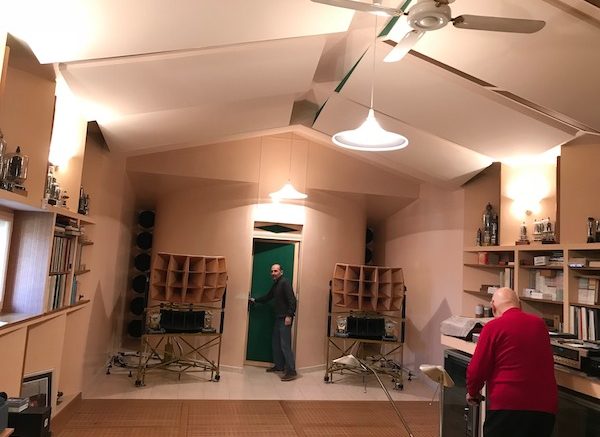
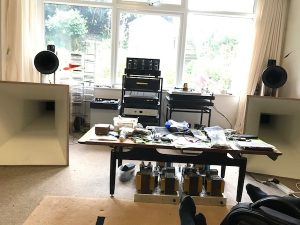
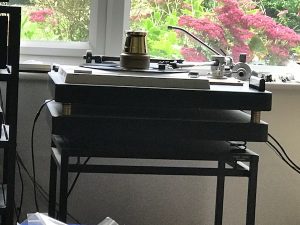
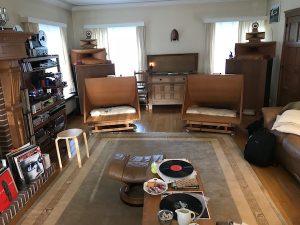
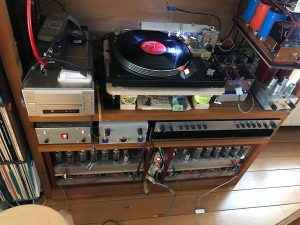
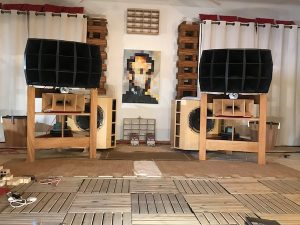
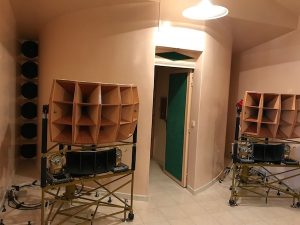
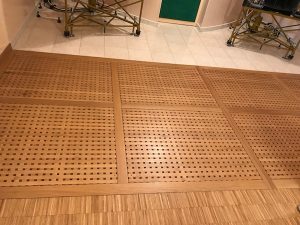
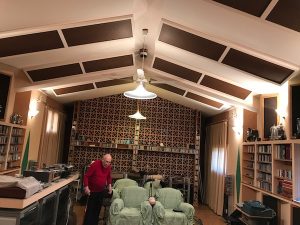
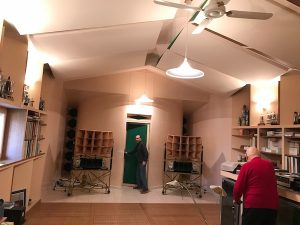
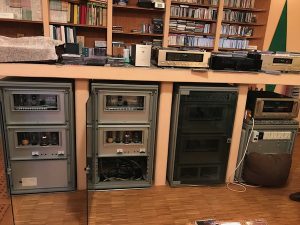
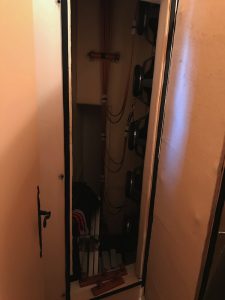
Be the first to comment on "DIY horns"